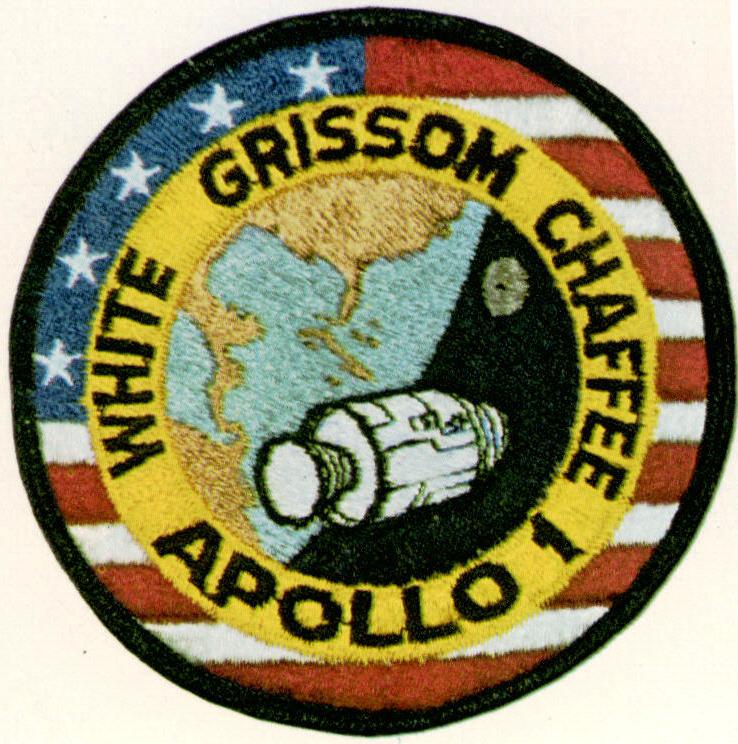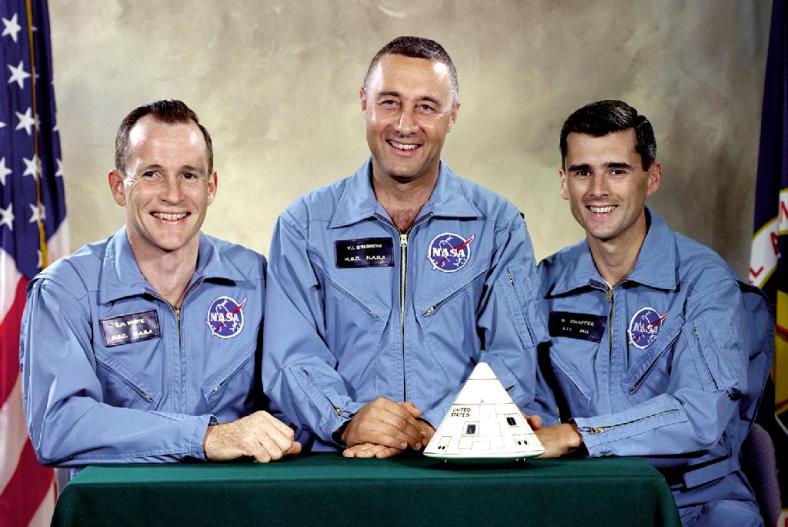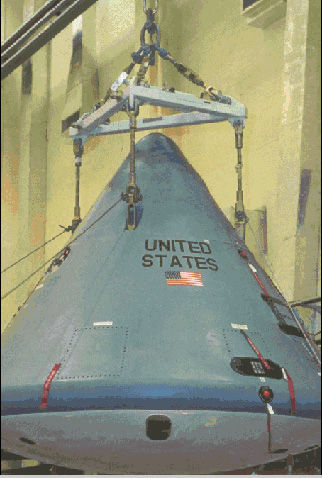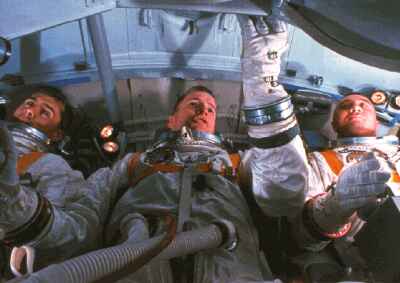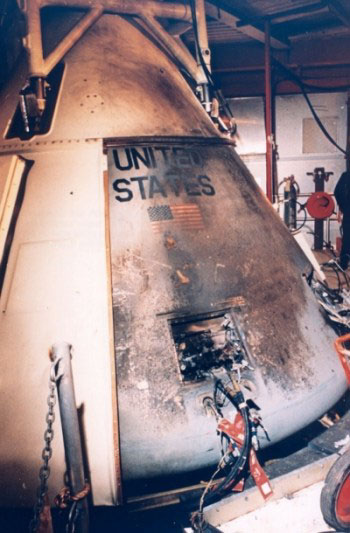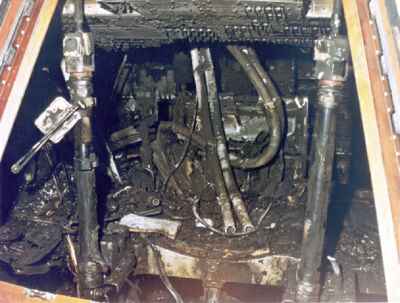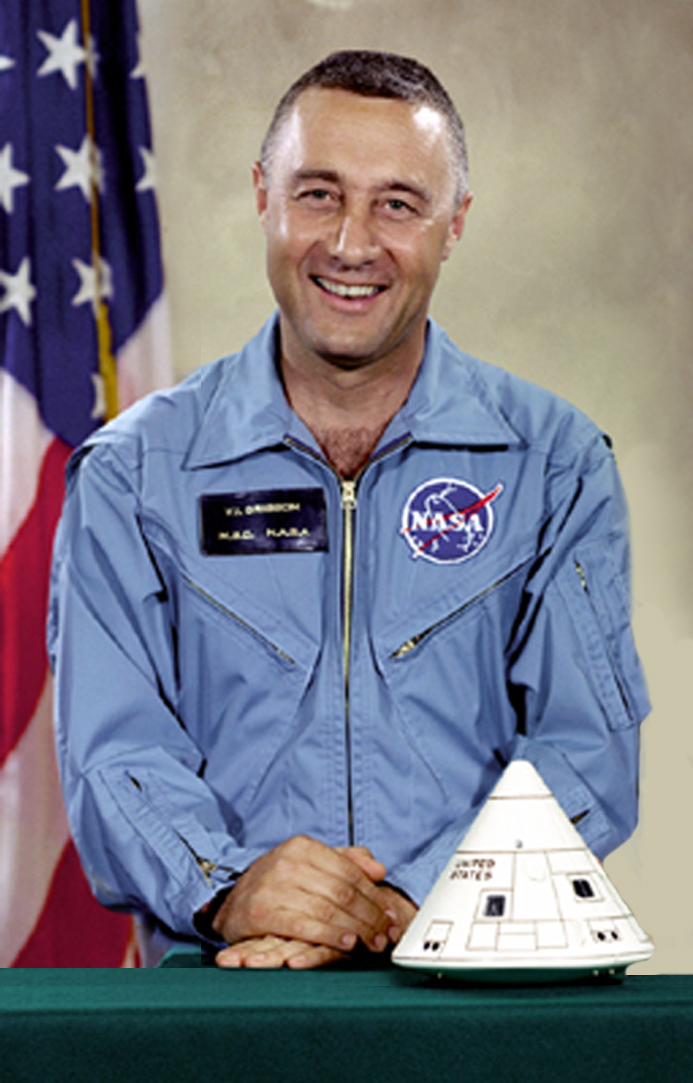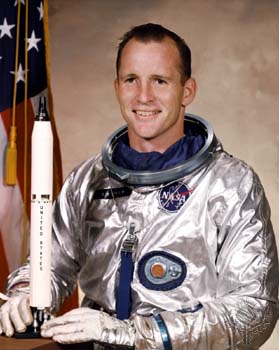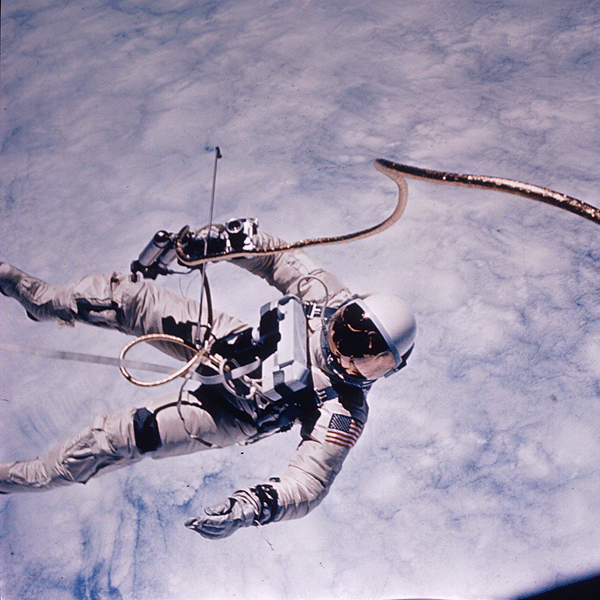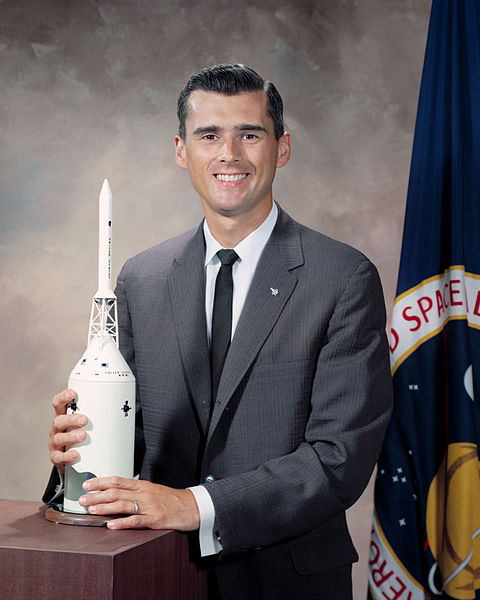
|
||||||||||||
|
|
|
Apollo 1
Edward White, Command Pilot Virgil "Gus" Grissom, Comander Roger Chaffee, Pilot 27 January 1967Tragic Loss of Three Apollo Astronauts
One of the worst tragedies in the history of spaceflight occurred on January 27, 1967 when the crew of Gus Grissom, Ed White, and Roger Chaffee were killed in a fire in the Apollo Command Module during a preflight test at Cape Canaveral. They were training for the first crewed Apollo flight, an Earth orbiting mission scheduled to be launched on 21 February. They were taking part in a "plugs-out" test, in which the Command Module was mounted on the Saturn 1B on the launch pad just as it would be for the actual launch, but the Saturn 1B was not fueled. The plan was to go through an entire countdown sequence.
Chaffee, White and Grissom At 1 p.m. on Friday, 27 January 1967 the astronauts entered the capsule on Pad 34 to begin the test. A number of minor problems cropped up which delayed the test considerably and finally a failure in communications forced a hold in the count at 5:40 p.m. At 6:31 one of the astronauts (probably Chaffee) reported, "Fire, I smell fire." Two seconds later White was heard to say, "Fire in the cockpit." The fire spread throughout the cabin in a matter of seconds. The last crew communication ended 17 seconds after the start of the fire, followed by loss of all telemetry. The Apollo hatch could only open inward and was held closed by a number of latches which had to be operated by ratchets. It was also held closed by the interior pressure, which was higher than outside atmospheric pressure and required venting of the command module before the hatch could be opened. It took at least 90 seconds to get the hatch open under ideal conditions. Because the cabin had been filled with a pure oxygen atmosphere at normal pressure for the test and there had been many hours for the oxygen to permeate all the material in the cabin, the fire spread rapidly and the astronauts had no chance to get the hatch open. Nearby technicians tried to get to the hatch but were repeatedly driven back by the heat and smoke. By the time they succeeded in getting the hatch open roughly 5 minutes after the fire started the astronauts had already perished, probably within the first 30 seconds, due to smoke inhalation and burns.
The Apollo program was put on hold while an exhaustive investigation was made of the accident. It was concluded that the most likely cause was a spark from a short circuit in a bundle of wires that ran to the left and just in front of Grissom's seat. The large amount of flammable material in the cabin in the oxygen environment allowed the fire to start and spread quickly. A number of changes were instigated in the program over the next year and a half, including designing a new hatch which opened outward and could be operated quickly, removing much of the flammable material and replacing it with self-extinguishing components, using a nitrogen-oxygen mixture at launch, and recording all changes and overseeing all modifications to the spacecraft design more rigorously.
Interior Of Command Capsule After The Fire The mission, originally designated Apollo 204 but commonly referred to as Apollo 1, was officially assigned the name "Apollo 1" in honor of Grissom, White, and Chaffee. The first Saturn V launch (uncrewed) in November 1967 was designated Apollo 4 (no missions were ever designated Apollo 2 or 3). The Apollo 1 Command Module capsule 012 was impounded and studied after the accident and was then locked away in a storage facility at NASA Langley Research Center. The changes made to the Apollo Command Module as a result of the tragedy resulted in a highly reliable craft which, with the exception of Apollo 13, helped make the complex and dangerous trip to the Moon almost commonplace. The eventual success of the Apollo program is a tribute to Gus Grissom, Ed White, and Roger Chaffee, three fine astronauts whose tragic loss was not in vain.
VIRGIL I. GRISSOM
(LIEUTENANT COLONEL, USAF) PERSONAL DATA: Born April 3, 1926, in Mitchell., Indiana. Died January 27, 1967, at NASA Kennedy Space Center, Florida, in the Apollo spacecraft fire. He is survived by his wife Betty and their two children. EDUCATION: Graduated from Mitchell High School; received a Bachelor of Science degree in Mechanical Engineering from Purdue University. ORGANIZATIONS: Member of the Society of Experimental Test Pilots. AWARDS: Posthumously awarded the Congressional Space Medal of Honor. SPECIAL HONORS: Distinguished Flying Cross and the Air Medal with cluster for his Korean service, two NASA Distinguished Service medals and the NASA Exceptional Service Medal; the Air Force Command Astronaut Wings. EXPERIENCE: Grissom, an Air Force Lieutenant Colonel, received his wings in March 1951. He flew 100 combat missions in Korea in F-86s with the 334th Fighter Interceptor Squadron and, upon returning to the United States in 1952, became a jet instructor at Bryan, Texas. In August 1955, he entered the Air Force Institute of Technology at Wright-Patterson Air Force Base, Ohio, to study Aeronautical Engineering. He attended the Test Pilot School at Edwards Air Force Base, California, in October 1956 and returned to Wright-Patterson in May 1957 as a test pilot assigned to the fighter branch. He has logged 4,600 hours flying time—3,500 hours in jet aircraft. NASA EXPERIENCE: Grissom was one of the seven Mercury astronauts selected by NASA in April 1959. He piloted the “Liberty Bell 7 spacecraft -- the second and final suborbital Mercury test flight -- on July 21, 1961. This flight lasted 15 minutes and 37seconds, attained an altitude of 118 statute miles, and traveled 302 miles downrange from the launch pad at Cape Kennedy. On March 23, 1965, he served as command pilot on the first manned Gemini flight, A 3-orbit mission during which the crew accomplished the first orbital trajectory modifications and the first lifting reentry of a manned spacecraft. Subsequent to this assignment, he served as backup command pilot for Gemini 6. Grissom was named to serve as command pilot for the AS-204 mission, the first 3-man Apollo flight Lieutenant Colonel Grissom died on January 27, 1967, in the Apollo spacecraft flash fire during a launch pad test at Kennedy Space Center, Florida.
EDWARD H. WHITE, II
(LIEUTENANT COLONEL) PERSONAL DATA: Born in San Antonio, Texas, on November 14, 1930. Died January 27, 1967, at NASA Kennedy Space Center, Florida, in the Apollo spacecraft fire. He is survived by his wife Patricia and their two children. EDUCATION: Bachelor of Science degree from United States Military Academy; Master of Science degree in Aeronautical Engineering, University of Michigan. ORGANIZATIONS: Associate member of Institute of Aerospace Sciences; Member of Sigma Delta Psi, athletic honorary; and Member of Tau Beta Pi, engineering honorary. AWARDS: Posthumously awarded the Congressional Space Medal of Honor. SPECIAL HONORS: Golden Plate Award; Honorary Doctorate degree in Astronautics, University of Michigan; NASA Exceptional Service Medal and Senior Astronaut Wings; Medalha Bandeirantes va Cosmonautica; Firefly Club Award; Ten Outstanding Young Men of the Nation for 1965; Five Outstanding Young Texans for 1965; The John Fitzgerald Kennedy Trophy; Aerospace Primus Club; 1966 Achievement Award, National Aviation Club; General Thomas White Award. EXPERIENCE: White, an Air Force Lieutenant Colonel, received flight training in Florida and Texas, following his graduation from West Point. He then spent 3-1/2 years in Germany with a fighter squadron, flying F-86’s and F-100’s. He attended the Air Force Test Pilot School at Edwards Air Force Base, California, in 1959. White was later assigned to Wright-Patterson Air Force Base, Ohio, as an experimental test pilot with the Aeronautical Systems Division. In this assignment he made flight tests for research and weapons systems development, wrote technical engineering reports, and made recommendations for improvement in aircraft design and construction. He logged more than 3,000 hours flying time, including more than 2,200 hours in jet aircraft. NASA EXPERIENCE: White was named as a member of the astronaut team selected by NASA in September 1962. He was pilot for Gemini 4, which was a 66-revolution, 4-day mission that began on June 3, and ended on June 7, 1965. During the third revolution, he carried out the first extra vehicular activity in the United States manned space flight program. He was outside Gemini 4 for 21 minutes, and became the first man to control himself in space during EVA with a maneuvering unit.
Other highlights of the mission included cabin depressurization, opening of cabin doors, and 12 scientific and medical experiments. He received the NASA Exceptional Service Medal and the U.S. Air Force Senior Astronaut Wings for this Flight. On March 21, 1966, he was named as one of the pilots of the AS-204 mission, the first 3-man Apollo flight. Lieutenant Colonel White died on January 27, 1967, in the Apollo spacecraft flash fire during a launch pad test at Kennedy Space Center, Florida.
ROGER B. CHAFFEE
(LIEUTENANT COMMANDER, USN) PERSONAL DATA: Born February 15, 1935 in Grand Rapids, Michigan. Died January 27, 1967, at NASA Kennedy Space Center, Florida, in the Apollo spacecraft fire. He is survived by his wife Martha and two children. EDUCATION: Chaffee graduated from Central High School, Grand Rapids, Michigan. He received a Bachelor of Science degree in Aeronautical Engineering, Purdue University in 1957. ORGANIZATIONS: Member, Tau Beta Pi, National Engineering Society, Sigma Gamma Tau, and Phi Kappa Sigma. AWARDS: Posthumously awarded the Congressional Space Medal of Honor. SPECIAL HONORS: Awarded the United States Navy Air Medal. EXPERIENCE: Chaffee, a United States Navy Lieutenant Commander, entered the Navy in 1957. He served as safety officer and quality control officer for Heavy Photographic Squadron 62 at the Naval Air Station in Jacksonville, Florida. In January 1963, he entered the Air Force Institute of Technology at Wright-Patterson Air Force Base, Ohio, to work on a Master of Science Degree in Reliability Engineering. He logged more than 2,300 hours flying time, including more than 2,000 hours in jet aircraft. NASA EXPERIENCE: Chaffee was one of the third group of astronauts selected by NASA in October 1963. In addition to participating in the overall training program, he was also tasked with working on flight control communications systems, instrumentation systems, and attitude and translation control systems in the Apollo Branch of the Astronaut office. On March 21, 1966, he was selected as one of the pilots for the AS-204 mission, the first 3-man Apollo flight. Lieutenant Commander Chaffee died on January 27, 1967, in the Apollo spacecraft flash fire during a launch pad test at Kennedy Space Center, Florida. CredIt:NASA |
